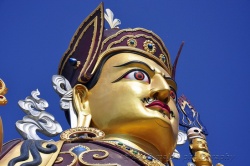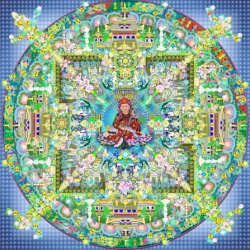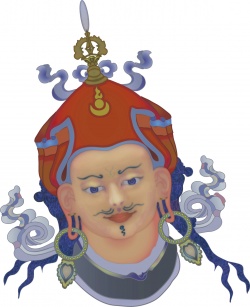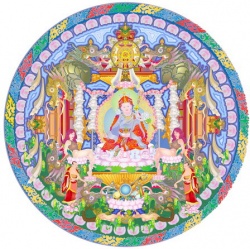Padmasambhava manifesting as Urgyen Dorje Chang
The Esoteric Buddha and the Lotus-Born Guru nature, its deeper significance. So in the Tantra the vajraguru introduces you to the level of consciousness embodied in the Tantric deities, and he names you - in a sense he tells you your true name, who you really are. Padmasambhava has many forms, including an important set of eight which are frequently represented in Tantric art. First there is simply the form known as Padmasambhava. He sits wearing the three robes of the monk, and a red cap. Behind him to one side is a basket, a container representing the nourishment of the spiritual food of the Tripitaka (the 'three baskets' of the sutras, the vinaya, and the abhidharma).
In some representations he is given Tantric attributes, holding a vajra and skull cup, and with an adept's staff held at his left side. Padmasambhava next manifests as Guru Sakya Senge ('lion of the Sakyas') or as Sakyamuni himself. In this form he appears in the way that Sakyamuni is usually represented: holding a begging-bowl, wearing the three yellow monastic robes, and golden yellow in complexion. Through this manifestation and the previous one he embodies the whole Buddhist tradition based on the sutras. This form also emphasizes the fact that Padmasambhava is described as a 'second Buddha' by his devotees. Next, however, he appears as Urgyen Dorje Chang (also known as Tshokyi Dorje). In this form he is deep blue in colour, adorned with silks and jewels, holding a vajra and bell.
He is locked in ecstatic sexual embrace with a consort, whose body is pure white. She holds a skull cup filled with ambrosia uplifted in her left hand. Here he embodies the whole Vajrayana tradition, whose source is said to be Vajradhara (or Dorje Chang in Tibetan). Now Padmasambhava transforms into Pema Gyalpo ('lotus king'). Here he is dressed like a king with a crown, jewels, and a turban. Around the turban is a diadem in which part of a wish-fulfilling gem can be seen. He sits relaxed in the posture of royal ease, holding a small Tantric double drum, known as a damaru, in his right hand, and a mirror in his left. His body is red in colour.
Another similar form appears, this time with natural skin colouring. He too wears royal attire and holds the damaru in his right hand. In his left he usually has a skull cup. In his belt is phurba, a kind of magic dagger. This is much used in Nyingma Tantric ritual. It was originally more like a peg or nail for pinning down demons and hindering psychic forces. It gradually became stylized into a three-edged blade ending in a point. The blade emerges from the body of a garuda. This implement embodies the power of a Tantric deity called Vajraklla.27 The phurba is often shown crowned with the head of Hayagriva, a protector of the Dharma whom we shall encounter in Chapter Seven.
The name of this manifestation is Lodan Choksey ('wise seeker of excellence'). Next, Padmasambhava enters the cremation ground, sits in meditation with his back to a stupa (or reliquary), and becomes Nyima Odzer ('sunrays guru'). This is Padmasambhava as siddha and yogin. He wears only a loincloth of tiger skin, a meditation sash, and a crown of skulls. Yellow light radiates from his body. His hair, combed upwards, is crowned with a vajra. In his right hand he holds a trident staff. With his left hand he plays with the rays of the sun. This recalls an incident in his life story in which Padmasambhava caused the sun to halt in its tracks.
He had made an agreement with a wine-seller to drink as much as he wanted and settle the bill at sunset. After seven days the sun still had not set. This is a good example of Tantric practice being bodied forth in legend. It has nothing whatever to do with alcohol. Rather it symbolizes Padmasambhava's entry into a state of consciousness in which time stands still, the mind and subtle psychic energies come to rest, and the yogin enjoys the mahasukha - or Great Bliss - uninterruptedly. The figures become wilder and more awe-inspiring. Next there appears a wrathful manifestation, Guru Senge Dradok ('one who teaches with a lion's voice'). He also wears a crown of skulls and a tiger skin. His body is circled by a necklace of skulls, his face contorted with fury. He brandishes a thunderbolt sceptre, and tramples underfoot forces inimical to the Dharma. Lastly we come face to face with Dorje Drolo ('immutable guru with loose-hanging stomach').
He rides through the jungle of life on a tigress. His expression is ferocious, and he is enhaloed with flames. His massive dark brown body is garlanded with skulls. He waves a thunderbolt in his right hand, and points a phurba with his left, to ward off all threatening forces. This is Padmasambhava as subduer of demons. These are eight of the forms that Padmasambhava assumes. They could be said to represent the guru's resourcefulness in transforming his approach to each situation, so as to teach in an appropriate way. He is not fixed in any mode of being or acting. Knowing that his nature is as empty as the blue sky, he can shift shape spiritually and psychologically, like clouds sculpting themselves into different forms and then dissolving. For stubborn-minded enemies of the Dharma, the guru musters even more power and energy; for those open to the sutras he teaches sutras; for those ready for the mysteries of Tantra he demonstrates Tantra. In this way he exemplifies upaya, or skilful means - the flexibility of the Buddhist teacher.
Padmasambhava's eight forms could also be seen as the same principle at work on different levels of consciousness. To the rational mind the guru appears as a pandit or a Buddha, and proclaims teachings on the Four Noble Truths and so forth. However, deeper more primitive strata of the mind are not amenable to being taught in this way. These aboriginal levels of consciousness need to be converted through the magic powers of figures like Nyima Odzer and Dorje Drolo. In summary, we can say that these differing manifestations mark Padmasambhava as the embodiment of all the resourcefulness of Buddhist teaching. They show him as the typical Tantric guru - working through logic and reasoning to convert the rational mind, but also diving deep into the psychic depths to confront, subdue, and transform the powerful and primitive - perhaps even demonic - energies that inhabit those dark realms. Though we have looked at so many forms, we have yet to meet Padmasambhava in his most frequent manifestation, as a king of Zahor.
In a sense you most truly meet a vajraguru when you receive initiation from him. So we shall try to venture out into the unknown to meet the Precious Guru, and be empowered with his knowledge, power, and compassion. We shall ask him to grant us siddhi, both mundane powers and the supreme siddhi of Enlightenment. These powers are emphasized in Padmasambhava's mantra: om ah hum vajraguru padma siddhi hum. To meet him we have to go to the place of initiation, to enter his secret realm. His realm, in which he flies like a great eagle, is the blue sky of sunyata. Initiation can only take place if we let drop our barriers and habitual ways of being, forsake our own territory, and enter the state of spiritual openness. In the vast blue sky appears a fiery-red lotus. On the lotus is a red sun disc (symbol of compassionate skilful means) lying horizontal; on the sun disc a white moon mat (symbol of the wisdom of realizing Emptiness). We wait, expectant. The lotus throne and sun and moon mats are like a great stage, on which the hero of a cosmic drama will appear. The blue sky above the moon mat begins to glow with brilliant light. The radiance gradually takes form, until we see a blissful young man seated before us.
(This is how he usually appears, though sometimes he can manifest instantaneously, from a dazzling bolt of lightning.) He is dressed in robes.2 The outermost is a beautifully decorated red cloak. This symbolizes the Mahayana. It is outermost because it is love and compassion which the Precious Guru offers to the world in all situations. Beneath the red cloak he wears the yellow robes of a monk - showing that though he follows the Tantric path beyond conceptual distinctions of right and wrong, he keeps pure his ethical discipline. He has not abandoned the basics of Buddhism, but simply carried them up into a higher vision. Beneath these he wears a blue robe.
Blue was the royal colour in ancient India. It became associated with the Tantra, as it incorporated much of the symbolism of royalty into its ritual. For example, we have seen that the Tantric initiation procedure in which the initiate is sprinkled with water from an initiation vase by the guru parallels the ceremony of anointing a king. So the blue robe which Padmasambhava wears, most hidden and closest to his heart, symbolizes the Vajrayana. He wears Tibetan-style boots, and sits totally relaxed, his left foot tucked up, his right resting at a loose angle. His right hand rests on his right knee, holding the vajra of Truth itself. He clasps it with his middle fingers, while his index and little fingers are outstretched, in the mudra of warding off demons and enemies of the Dharma. It is said that Padmasambhava's power increases as worldly conditions deteriorate.
He is the supreme alchemist, the master who transforms hatred into wisdom, craving into love, darkness into light. The more powerful the forces of evil become, the more lustrous his form appears. In the depths of despair and annihilation, his diamond wisdom shines like a great lamp. Difficulties, opposition, and danger fuel his spiritual power. In his left hand he holds a skull cup filled with something that looks suspiciously like blood. The skull cup represents sunyata, and the liquid it contains is the amrit-nectar of Great Bliss. With the realization of the emptiness of self and others, a revolution takes place in our experience. The forces of desire, which caused us so much restlessness and pain, now give us bliss. The problem with pleasure is that we usually experience it within the framework of subject and object.
It reinforces our feeling of being an 'I', 'in here', trying to incorporate a pleasurable stimulus 'out there'. The result is craving and frustration. When self and other dissolve away, there is just enjoyment, with no attempt to nail it down, or strangle it by repetition. William Blake well sums up the difference: He who binds to himself a Joy Doth the winged life destroy; But he who kisses the Joy as it flies Lives in Eternity's sunrise. The skull cup symbolizes the death of the ego, the spiritual death which creates space - the experience of the 'open dimension' of sunyata. The nectar is like blood, for blood is life, the free-flowing energy capable of assuming any form , which is released with Insight. In Nyingma circles this ambrosia - the Great Bliss experience - is often symbolized, for obvious reasons, by beer or wine.
Rising up out of the skull cup is a vase of the Nectar of Immortality. Above it is a precious jewel - the wishfulfilling gem of the Bodhicitta. In the crook of Padmasambhava's left arm nestles a trident staff, known as a khatvanga. It is adorned with a number of strange objects. A damaru hangs from it. There are crossed vajras. Above them is a vase of initiation adorned with victory pennants. Then there are three human heads: one freshly severed, one decomposing, the top one just a skull. Finally, the staff is surmounted by a flaming trident. The net of symbolic associations surrounding the different elements of the staff is complex, and we do not have space to discuss them individually. We shall look at just two aspects of the staff overall.
The first is that the staff is spoken of as the hidden consort. According to the biography of Yeshe Tsogyal, who was one of Padmasambhava's chief female disciples, at one point the Precious Guru wanted to travel with her, without her being seen, so he magically transformed her into his staff.30 Thus the khatvanga symbolizes all the spiritual qualities that the Vajrayana associates with the feminine (principal among which is wisdom). Padmasambhava's holding the staff indicates that he has perfectly integrated these qualities. Also, the khatvanga is a magic staff, and Padmasambhava is the peerless spiritual magician. It was through his magic powers that he defeated the Bon shamans and subdued the demons of Tibet. Through his sadhana you magically transform yourself, turning the base metal of your mundane consciousness, the lead of ignorance, into the gold and jewels of Tantric attainment. On his head the Precious Guru wears a lotus cap - red in colour.
It is one of many hundreds of kinds of hat to be found in the Tantra - each with its own particular significance. This one has flaps which can come down over the ears. On its front are five jewels, arranged in a mandala pattern - white in the center, blue, yellow, red, and green around - symbolizing the five wisdoms. Above them is a crescent moon surmounted by a golden sun. These symbolize the subtle energies of the psychophysical organism, which Padmasambhava has unified, thereby bringing an end to all dualistic thoughts. The cap is crowned with a half vajra with a vulture's feather rising out of it. The vulture is a bird associated with yogins - because it is said to be the bird that flies the highest. Padmasambhava wears ornate earrings, and a priceless necklace of jewels. He has long flowing locks, a moustache, and a small pointed beard.
His gaze is piercing. His face has a strange expression, a kind of compassionate smile, but tinged with wrathfulness. His smile is a challenge. We can say that it symbolizes the union of compassion (the smile) and wisdom (the wrathful gaze), but that does not explain it away. This wrathful smile is a key to understanding Padmasambhava. It is mysterious and unfathomable. Sometimes when his visualization dissolves I am left with the after-image of that dangerous smile, hanging in the sky like an Enlightened version of the Cheshire Cat. But, if Padmasambhava is a cat at all, he is a leopard or tiger of the Dharma.
His body is adorned with what are called his three vajras: a white om at his forehead, a fiery red ah at his throat, and a deep-blue hum at his heart. They are like three special concentrations of Padmasambhava's immense spiritual power. It is from them that, if one is ready to run the gauntlet of the blue sky and dare that dangerous smile, one will receive the Precious Guru's initiation, be empowered with both mundane siddhis and the supreme siddhi of Enlightenment itself, and become a king or queen of the Dharma.




